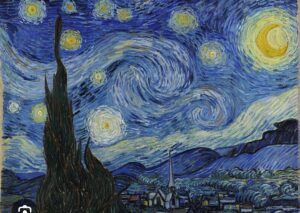𝙏𝙞𝙩𝙡𝙚 : 𝙏𝙝𝙚 𝙏𝙪𝙧𝙗𝙪𝙡𝙚𝙣𝙩 𝙉𝙞𝙜𝙝𝙩( 𝘐’𝘷𝘦 experimented 𝘮𝘺 𝘰𝘸𝘯 𝘱𝘰𝘦𝘵𝘳𝘺 𝘴𝘵𝘺𝘭𝘦 𝘵a𝘬𝘪𝘯𝘨 𝘪𝘯𝘴𝘱𝘪𝘳𝘢𝘵𝘪𝘰𝘯 𝘧𝘳𝘰𝘮 𝘎𝘶𝘭𝘻𝘢𝘳’𝘴 𝙏𝙧𝙞𝙫𝙚𝙣𝙞 𝙛𝙤𝙧𝙢)
She held her still born child blue black,
The quiet hamlet moaned a soft dirge,
𝗧𝗵𝗲 𝗲𝗯𝗼𝗻𝘆 𝘀𝗸𝘆 𝘀𝘂𝗿𝗴𝗲𝗱 𝘄𝗶𝘁𝗵 𝘄𝗮𝘃𝗲𝘀 𝗼𝗳 𝗺𝗼𝗼𝗻𝗯𝗲𝗮𝗺𝘀.
The dreams she had weaved during her pregnant months,
Seemed to rapidly drift away to the skies above,
𝗧𝗵𝗲 𝗯𝗹𝘂𝗿𝗿𝘆 𝘀𝘁𝗮𝗿𝘀 𝗲𝘅𝗽𝗹𝗼𝗱𝗲𝗱 𝘄𝗶𝘁𝗵 𝘄𝗶𝘀𝗵𝗲𝘀 𝘂𝗻𝗯𝗼𝗿𝗻.
The loss and pain strained her fragile heart,
Agonized– tears gushed down her soft cheeks,
𝗧𝗵𝗲 𝘁𝘂𝗿𝗯𝘂𝗹𝗲𝗻𝘁 𝗳𝗶𝗿𝗺𝗮𝗺𝗲𝗻𝘁 𝘄𝗮𝘀 𝗵𝘂𝗲𝗱
𝘄𝗶𝘁𝗵 𝗿𝗮𝗶𝗻𝗶𝗻𝗴 𝘁𝗲𝗮𝗿𝘀.
Ruthless was death–pleas several fell on deaf ears,
She solemnly wrapped the child with shivering hands,
𝗔 𝘁𝗮𝗹𝗹 𝗴𝗿𝗶𝗺 𝘁𝗿𝗲𝗲 𝘀𝘁𝗼𝗼𝗱 𝘀𝗶𝗹𝗵𝗼𝘂𝗲𝘁𝘁𝗲𝗱 𝗮𝗴𝗮𝗶𝗻𝘀𝘁 𝘁𝗵𝗲 𝗹𝗮𝗻𝗱𝘀𝗰𝗮𝗽𝗲𝗱 𝗰𝗮𝗻𝘃𝗮𝘀.
***

𝗛𝗲𝗿𝗲’𝘀 𝘁𝗵𝗲 𝗧𝗿𝗶𝘃𝗲𝗻𝗶 𝗳𝗼𝗿𝗺
The Triveni is a form that Gulzar began experimenting with in the mid-1960s. It gets its name from the fact that it is composed of three lines. It is different from other three-line forms like the haiku and senryu, which have a fixed limit on the syllable count and in essence describe one image.
As Gulzar says, “I called it Triveni because the first two lines meet like the Ganga and the Yamuna and complete a thought, it forms a poem on its own. But beneath the two there is the subterranean flow of another, the Saraswati. Hidden. Not visible to the eye. The Triveni intends to reveal the Saraswati. The third line, lost in the first two, either changes the meaning of the poem altogether, its focus, or gives it a surprising twist, in the process creating an entirely new poem altogether.’
Examples of Triveni :-
ज़ुल्फ़ में यूँ चमक रही है बूँद
जैसे बेरी में तनहा एक जुगनू
क्या बुरा है जो छत टपकती है
𝗜𝗻 𝗺𝘆 𝗽𝗼𝗲𝘁𝗿𝘆 𝘁𝗵𝗲 𝘁𝗵𝗶𝗿𝗱 𝗹𝗶𝗻𝗲 𝗺𝗮𝘆 𝗻𝗼𝘁 𝗲𝗻𝘁𝗶𝗿𝗲𝗹𝘆 𝗺𝗲𝗮𝗻 𝘀𝗼𝗺𝗲𝘁𝗵𝗶𝗻𝗴 𝘁𝗼𝘁𝗮𝗹𝗹𝘆 𝗱𝗶𝗳𝗳𝗲𝗿𝗲𝗻𝘁 𝗯𝘂𝘁 𝘄𝗵𝗲𝗻 𝗼𝗻𝗲 𝗰𝗼𝗺𝗯𝗶𝗻𝗲𝘀 𝘁𝗵𝗲 𝘁𝗵𝗶𝗿𝗱 𝗹𝗶𝗻𝗲 𝗳𝗿𝗼𝗺 𝗮𝗹𝗹 𝟰 𝘀𝘁𝗮𝗻𝘇𝗮𝘀 𝗶𝘁 𝘀𝗶𝗴𝗻𝗶𝗳𝗶𝗲𝘀 𝘀𝗼𝗺𝗲𝘁𝗵𝗶𝗻𝗴 𝘁𝗼𝘁𝗮𝗹𝗹𝘆 𝗱𝗶𝗳𝗳𝗲𝗿𝗲𝗻𝘁 𝘄𝗵𝗶𝗰𝗵 𝗵𝗲𝗿𝗲 𝗶𝘀 𝘁𝗵𝗲 𝗽𝗮𝗶𝗻𝘁𝗶𝗻𝗴 ” 𝗧𝗛𝗘 𝗦𝗧𝗔𝗥𝗥𝗬 𝗡𝗜𝗚𝗛𝗧 𝗯𝘆 𝗩𝗶𝗻𝗰𝗲𝗻𝘁 𝗩𝗮𝗻 𝗚𝗼𝗴𝗵


